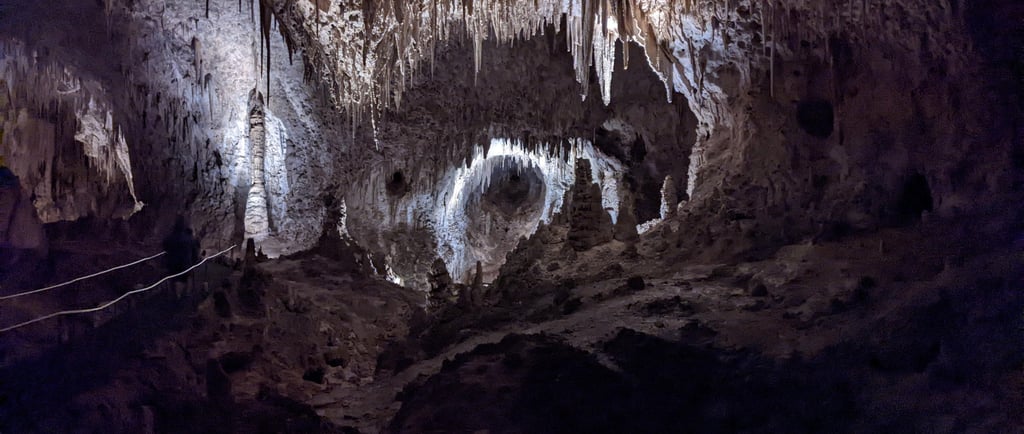Cave Week Day 1: Welcome to the Abyss. Hope You Brought a Pipette.
Welcome to Cave Week. We’re starting deep—literally. Caves aren’t just spooky holes in the ground; they’re full-blown science labs where geology, microbiology, ecology, and madness collide. This week, we’re dragging the spotlight underground to show you what’s lurking in the abyss—and why it matters.
FERAL SCIENCECAVE & KARSTBATSCAVE WEEK
6/1/20254 min read
🕳️ IT IS DAY 1 OF CAVE WEEK! 🕳️
Look. We love the sun like everyone else. Photosynthesis? Big fan. Vitamin D? Sure. But if you really want to understand how this planet works—how life survives, evolves, and occasionally screams into the abyss? You go underground. Welcome to Cave and Karst Week—the one time a year we’re socially permitted to shout about limestone and microbial horror shows without someone telling us to "touch grass." Spoiler: we do. But it’s biocrust. And it bites.
Why Study Caves?
Because caves are metal as hell. They're not just rock holes or tourist traps with souvenir mugs. They’re ancient, brutal, and alive. Caves:
🦇 Supply drinking water to 700+ million people
🦇 Harbor lifeforms that laugh in the face of radiation and starvation
🦇 Hold fossils, pathogens, and climate records etched in dripstone
🦇 Contain entire ecosystems that function without light
🦇 Occasionally collapse and eat a car (looking at you, sinkholes)
🦇 Caves are where geology, biology, and pure chaos high-five in the dark. And we are absolutely here for it.
Bats: The Night Shift MVPs
Let’s get this straight: Bats are not the problem. Humans are. These winged legends keep our ecosystems alive. One bat can eat thousands of insects a night—including pests that wreck crops or carry disease. Some pollinate plants. Others disperse seeds. And all of them are essential to cave ecosystems.
What are scientists doing?
🦇 Tracking endangered species
🦇 Studying white-nose syndrome (a cave-born fungal hell plague)
🦇 Mapping migration, roosting, and disease patterns
🦇 Building conservation strategies so we don’t screw this up more than we already have
At CHAOS, we coordinate cave visits with bat biologists to avoid disturbing roosts. Because bat tantrums are justified, and they don’t like your LED headlamp.
Ecology in the Abyss
You think the rainforest is biodiverse? Try a cave. No sunlight. No plants. No mercy. Just organisms adapted to extreme pressure, low nutrients, and total darkness.
Inside, you’ll find:
🌱 Troglobites: blind, ghostly cave-adapted creatures
🌱 Guano-fueled food webs (yes, this is the real circle of life)
🌱 Microbes surviving on rock, sulfur, and grit
🌱 Whole ecosystems that collapse if one spelunker gets clumsy
Scientists study how these organisms survive, evolve, and react to change. Because if life can make it down here, it might make it anywhere—Mars, Europa, or whatever flaming trash heap Earth is turning into.
Hardcore Geology: Caves Don’t Lie
Caves are geological memoirs, written in mineral veins and meltwater scars. Want to know where your groundwater’s going? Study karst. Want to find radon, a sneaky little radioactive gas that ruins basements and lungs? Study caves. Want to understand how ancient climates changed? Stalactites and stalagmites are the goth data loggers of the Earth.
Geologists crawl through the underworld to map aquifers, decode collapse risks, and trace the violent, beautiful history of how rock meets water. Also, we lick nothing in the caves. (Mostly.)
NASA in a Cave? Yeah.
In an Iowa cave, NASA stuck volunteers underground to simulate life on Mars. No light. No time. No tweets. Why? To study how the brain handles isolation, sensory deprivation, and the crushing silence of long-term missions. Turns out, cave science is space science. Welcome to the crossover episode no one saw coming.
500 Days in a Cave—Voluntarily
Beatriz Flamini, Spanish badass, spent 500 days in a cave. Alone. No clocks. No human contact. She missed two birthdays, a pandemic phase shift, and a literal war. She emerged fine. Better than fine. Chill. Sharp. Psychologically stable. Scientists now study her to figure out how the hell that’s possible. Meanwhile, we lose our minds if the Wi-Fi drops for ten minutes.
Bones, Teeth, and Humanity’s Echo
Caves are where dead things go to last forever. Some of our most important fossil discoveries—Denisovans, early humans, Neanderthal tools, and even 40,000-year-old cave art—came from deep underground. These aren’t museums. They’re time machines. Anthropologists and paleontologists sometimes work in extreme conditions to recover pieces of our story—before they dissolve, collapse, or get stepped on by someone trying to get a selfie.
Bioprospecting & Microbial Mayhem
Cave microbes are weird. We love them for it. They’ve evolved to survive acid, starvation, heavy metals, and no light. That makes them exactly the kind of organisms we want in:
💊 Antibiotic discovery
⚙️ Industrial biotech
🦠 Cancer therapies
⚡ Bioenergy development
👁️ Clues to life beyond Earth
The CHAOS Lab specializes in Appalachian cave microbiomes. We swab rock. We sequence DNA. We look for the microscopic monsters that could save lives—or at least melt metal in a cool way.
CHAOS Lab, Reporting from the Underworld
What are we doing for Cave Week? Same thing we do every week—study the ancient, the extreme, and the medically curious:
💥 Hunting extremophiles in Appalachian cave systems
💥 Mapping how bedrock and water chemistry shape microbial survival
💥 Linking geology to public health risks—because yes, rocks affect your body
💥 Avoiding bat zones, biocrusts, and questionable rope systems
💥 Building the first microbial biodiversity atlas of Kentucky’s subsurface
We believe in dark science. Glitter-free data. And respecting the crust.
Final Thought: Caves Aren’t Empty
They are alive, and they are listening. Bats. Bones. Bacteria. Beneath our feet, an entire world pulses with secrets. Caves aren't dead space. They are engines. Libraries. Weapon forges.
And for those of us chasing truth in the dark? They're home. So light a headlamp, grab your boots, and don’t lick the walls.
It’s Cave Week. Let’s get weird. 🪨


Welcome to the underworld.
